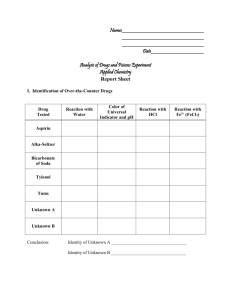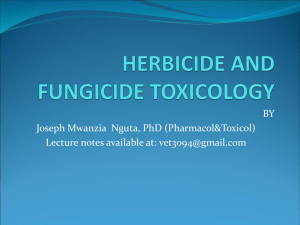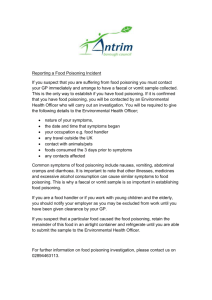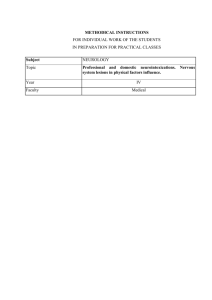MS DOC
advertisement
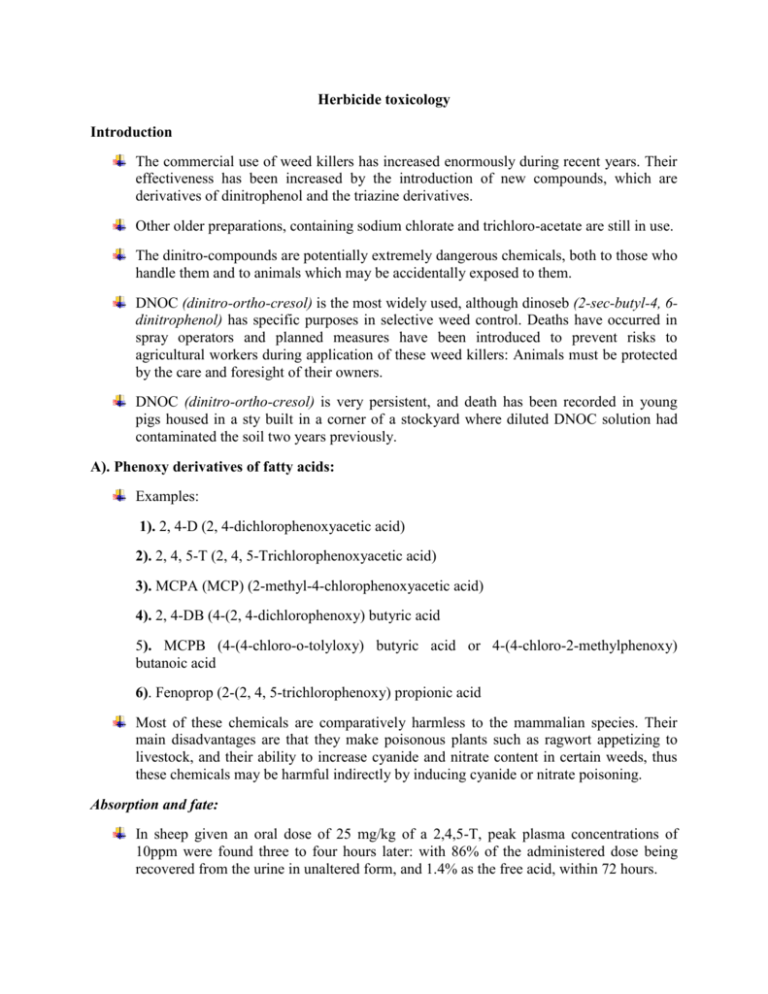
Herbicide toxicology Introduction The commercial use of weed killers has increased enormously during recent years. Their effectiveness has been increased by the introduction of new compounds, which are derivatives of dinitrophenol and the triazine derivatives. Other older preparations, containing sodium chlorate and trichloro-acetate are still in use. The dinitro-compounds are potentially extremely dangerous chemicals, both to those who handle them and to animals which may be accidentally exposed to them. DNOC (dinitro-ortho-cresol) is the most widely used, although dinoseb (2-sec-butyl-4, 6dinitrophenol) has specific purposes in selective weed control. Deaths have occurred in spray operators and planned measures have been introduced to prevent risks to agricultural workers during application of these weed killers: Animals must be protected by the care and foresight of their owners. DNOC (dinitro-ortho-cresol) is very persistent, and death has been recorded in young pigs housed in a sty built in a corner of a stockyard where diluted DNOC solution had contaminated the soil two years previously. A). Phenoxy derivatives of fatty acids: Examples: 1). 2, 4-D (2, 4-dichlorophenoxyacetic acid) 2). 2, 4, 5-T (2, 4, 5-Trichlorophenoxyacetic acid) 3). MCPA (MCP) (2-methyl-4-chlorophenoxyacetic acid) 4). 2, 4-DB (4-(2, 4-dichlorophenoxy) butyric acid 5). MCPB (4-(4-chloro-o-tolyloxy) butyric acid or 4-(4-chloro-2-methylphenoxy) butanoic acid 6). Fenoprop (2-(2, 4, 5-trichlorophenoxy) propionic acid Most of these chemicals are comparatively harmless to the mammalian species. Their main disadvantages are that they make poisonous plants such as ragwort appetizing to livestock, and their ability to increase cyanide and nitrate content in certain weeds, thus these chemicals may be harmful indirectly by inducing cyanide or nitrate poisoning. Absorption and fate: In sheep given an oral dose of 25 mg/kg of a 2,4,5-T, peak plasma concentrations of 10ppm were found three to four hours later: with 86% of the administered dose being recovered from the urine in unaltered form, and 1.4% as the free acid, within 72 hours. There was less than 0.1ppm of 2, 4, 5-T in the tissues; but in sheep poisoned by repeated doses of 2, 4, 5,-T, the tissue levels were 368 ppm. Sheep dying after repeated daily doses of 300-500 mg/kg of 2, 4-D had levels of up to 2600 ppm in the rumen contents, plasma levels of 225-500ppm, and urine levels of 65007500 ppm. Even after large doses were given to cows, no 2, 4-D was found to be excreted in the milk, although the compound apparently circulates unchanged in the blood. Toxicity: These compounds differ but little in toxicity, the LD50 for most species lying in the range 100-500 mg/kg. The dog is probably the most susceptible species, poultry the least. This group of herbicides also has a low degree of chronic toxicity; 2,4-D and 2,4,5,-T can be tolerated without adverse effects in doses only slightly lower than those which cause toxic effects when given in a single dose. The general picture is that if a single dose of 500 mg/kg will kill, 10 daily doses of 200 mg/kg will be fatal, but 100 mg/kg may be administered daily without ill-effects. With dogs, however, a daily dose of 20 m g/kg of 2, 4-D or 2, 4, 5-T will quickly produce signs of poisoning. Dogs fed 500ppm of 2, 4-D in the diet for two years remained clinically normal. 2, 4, 5-T has been used as a defoliant and is linked with lung cancer and teratogenic effects. It is (2, 4, 5-T) considered very dangerous because of the presence of small quantities of a highly toxic by product, tetrachlorodibenzodioxin or TCDD. Experimental evidence has confirmed that TCDD is one of the most poisonous substances known; the acute lethal dose for a guinea pig is about 1µg. Teratogenic effect in rats has been shown following dosage with TCDD. Smaller herbivores are more vulnerable to the toxic effects of TCDD than larger species. Clinical signs and lesions. Animals poisoned present an overall picture of loss of appetite, loss of weight, depression, unthrifty appearance, general tenseness and muscular weakness, particularly in the hind legs. Large oral doses elicit vomiting in those species capable of doing so. Also abortion, irregular oestrus, anoestrus and ovarian atrophy in cattle may be attributed to the consumption of herbage contaminated with 2, 4-D. Vomiting, with death has been reported in a dog which drank from a ditch sprayed with a 2, 4, 5-T ester. The stomach contained 2000 ppm of 2, 4, 5-T. Horses grazing pasture which had been sprayed with a mixture of 2,4,-D and 2,4,5-T showed depression, salivation, inability to drink, muscular tremors and jaundice of mucous membranes, with death occurring in 2-10 days. Postmortem findings following oral dosage usually include irritation of the stomach of small animals and of the abomasum of ruminants, minor evidence of liver and kidney injury and in some instances, congestion of the lungs. Dogs show a considerably greater susceptibility to the development of liver damage than other species. There is also haemorrhagic gastritis with ecchymotic haemorrhages on the wall of the intestine, stomach ulcerations and degenerative changes of the liver and kidneys. B). Dinitro Compounds. This group of herbicides includes 2, 4-dinitrophenol (DNP), Dinitro-orthocresol (DNOC) and dinoseb. The free compounds are yellow and form deep orange or reddish salts. Absorption and fate: Absorption of dinitro compounds can take place with ease through the lungs, the gut or the intact skin. The rate of absorption through skin is likely to be greater when the substances are applied in oily rather than aqueous solution. The chief risk to animals is from spillages or contamination of vegetation or water. When DNOC is absorbed via the mouth of simple stomached animals, the liver converts it into a mixture of less toxic metabolites, mainly the isomeric monoamines and their derivatives that are excreted via the kidneys. In the case of ruminants, the rumen micro-organisms rapidly reduce DNOC mainly to the diamino compound that is then absorbed by the host and conjugated in the liver. Methaemoglobinaemia has also been reported in ruminants. The action of dinitrophenols is to uncouple oxidative phoshorylation: they stimulate tissue respiration and at the same time impair the synthesis of adenosine triphosphate (ATP). The overall result is that metabolism is accelerated, but the energy produced is converted into heat instead of being passed on, through the mediation of ATP, to those chemical and physical processes which require it. One important factor in the DNOC toxicity is the effect of environmental temperatures: high temperatures (37-400C), markedly increase the toxicity of DNOC, and experimental studies on laboratory animals have indicated that the toxicity may be increased 25-fold. Low environmental temperature decreases the toxicity. Toxic dose: The approximate oral LD50 of DNOC is 25-50 mg/kg, depending on species, environmental temperature and route of administration. There is some cumulative effect. In sheep, 12.4 mg/kg produces signs of poisoning in seven weeks, 18.6 mg/kg in six days and 24.8 mg/kg in five days, the latter dose being lethal. The toxicity of DNP is similar to that of DNOC, and its magnitude is dependent on similar factors. Clinical signs: The signs of intoxication are much the same in all species and include listlessness, loss of appetite and activity, deepened and more rapid respiration, sweating (in some animals only), thirst, oliguria, muscular weakness, prostration, dyspnoea and death, with terminal hyperpyrexia. Signs may appear within a few minutes if large amounts have been ingested, otherwise they may be delayed for several hours. Diagnosis: DNOC and other dinitro compounds are persistent yellow dye-stuffs, staining exposed skin, hair, wool, fur and feathers a distinct yellow or orange colour which remains obvious for weeks or even months afterwards, despite the action of water and weather. Such staining provides evidence of at least external contact with the chemicals. Stomach contents, liver and specimens of any yellow coloured organs should be submitted for laboratory examination. The dinitro compounds impart a peculiar yellowish-green colour to the urine, sometimes described as a chrome yellow or fluorescent yellow hue. The sclera may also be yellowstained. Treatment: There is no specific antidote for poisoning with dinitrophenols: treatment must therefore be largely non-specific. The animal should be kept in as cool an environment as possible, sedatives(barbiturates) may be given to keep it quiet and water and/or glucose/physiological saline can be used in the appropriate fashion to combat dehydration due to sweating. Sedatives must be used with care as some (including chlorpromazine) have been found to potentiate the action of DNOC. In man, respiratory distress is greatly relieved by administration of oxygen. It has been suggested that the intravenous injection of a solution of sodium methyl thiouracil might be effective in reducing the basal metabolic rate. C). Chlorinated compounds and similar compounds: Sodium chloroacetate and TCA (sodium trichloro-acetate) are both relatively harmless herbicides. The former is the more toxic, having an LD50 in rats of 650 mg/kg; the figure for cattle being 150 mg/kg. TCA has an LD50 in rats of 3000-5000 mg/kg. Free trichloroacetic acid is an extremely corrosive substance. Trichlorobenzoic acid (2, 3, 6-TBA; Trysben) is widely used as a non selective weed killer. It is of low toxicity, the lethal dose in rats being 1500 mg/kg. Dicamba and dalapon are less toxic still. Chlormequat has a lethal dose of 200 mg/kg in sheep, but does not constitute a toxic hazard to stock if properly used. D). Triazine Herbicides: The triazine herbicides (atrazine; simazine; propazine; prometone and aminotriazole) are of fairly low toxicity. The lethal dose of simazine (Weedex) in the sheep is 500 mg/kg. Signs of poisoning such as weakness, ataxia and posterior paralysis may not appear until three weeks after ingestion. Prometone is considerably more toxic, with poultry being less susceptible than sheep and cattle. Aminotriazole has a lethal dose of 4g/kg in sheep. It gives rise to the stimulation of smooth muscle of the gut and bronchi, and causes oedema of the lungs and severe haemorrhages of the stomach and intestines. E). Thiocarbamates The thiocarbamates, di-allate and tri-allate, are used for controlling weeds in farm crops. The former is the more toxic, having an LD50 in rats of 400 mg/kg against 2000 mg/kg for tri-allate. Sheep may be poisoned by 300 mg/kg of tri-allate, showing signs of depression, anorexia, salivation, weakness, convulsions and paresis. Daily dose of 50 mg/kg of di-allate will eventually cause poisoning in sheep. F). Bipyridyls: The bipyridyl herbicides, diquat and paraquat (Gramoxone, Weedol), are well known in toxicology owing to the number of fatal cases of human poisoning which they have caused. They give rise to a proliferative alveolitis and bronchiolitis, and unless the amount consumed is small, treatment is of little avail. Poisoning in domestic animals has occurred less frequently than in man. In all cases, it has been due to carelessness or malice, as these substances are unlikely to cause any serious harm if properly used. Cattle show no toxic effects after grazing on pasture freshly sprayed with paraquat, although show lesions of the mouth which heal quickly on removal to clean pasture. Cattle drinking from an old diquat container full of rain water showed anorexia, ataxia, recumbency and coma with intense abomasitis, epicardial haemorrhages and congestion of the lungs at post mortem. The levels of diquat found were: liver 21ppm; kidney 14 ppm; abomasum 8.5 ppm and brain 2.0 ppm. Pigs poisoned with paraquat show vomiting, dyspnoea, depression, jaundice and severe pain; post mortem lesions include pulmonary oedema, congested liver, interlobular oedema, gastroenteritis, enlarged spleen and petechiae in the trachea. Dogs poisoned with paraquat show signs similar to those in poisoned pigs, with congested liver and lungs at post mortem. A dose of 40 ppm paraquat in the drinking water has shown no effect on hens except slight decrease in egg fertility. Lethal doses of diquat are: in cattle 30 mg/kg, in dogs 100-200 mg/kg, and in poultry 200-400 mg/kg. Of paraquat: in cattle 50 mg/kg, in sheep 100 mg/kg, in pigs 75 mg/kg, and in poultry 200 mg/kg. II. Fungicide toxicology Introduction: Substances of widely varying chemical constitution have been used or are being developed as fungicides. They include copper compounds, sulphur preparations, inorganic and organic derivatives of mercury and miscellaneous organic compounds. The main hazard to livestock from fungicides is likely to arise from their use as seed dressings for the protection of stored grain, potatoes and a number of cases are on record of poisoning in horses, cattle, pigs and poultry caused by the unwitting feeding of treated grain. Of the fungicides used as seed dressings, it has been shown that the following are unlikely to be harmful to stock in the amounts normally used: dithiocarbamate compounds, tecnazene (used on stored potatoes to retard germination), propham (also used as herbicide) and captan. A). Organomercury compounds These include phenyl mercury chloride, phenyl mercury acetate and various aliphatic compounds such as ethylmercury chloride, iodide and phosphate; toluene sulphonanilide, methylmercury acetate, chloride and hydroxide; methylmercury dicyandiamide and mercury silicate (methoxethyl) used as seed dressings in agriculture. Mercurial compounds were once combined with aldrin or dieldrin as seed dressings. The combination was particularly dangerous to wild birds. The mercurial seed dressings have been responsible for numerous outbreaks of poisoning owing to grain treated with them having been mistakenly used as food for man or beast. There is normally a lapse of several weeks between the beginning of the feeding of the grain and the sudden onset of clinical signs, but death is usually rapid once these, which may include anorexia, ataxia, diarrhea, petechial haemorrhages, blindness and nervous signs, have set in. Experimentally, it has been shown that the lethal dose of methylmercury dicyandiamide in the pig is 20 mg/kg. Ethylmercury chloride is rather more poisonous, phenyl mercury chloride rather less so. Calves given methyl mercuric chloride showed ataxia, neuromuscular in coordination and convulsions, the clinical signs developing in five to 13 weeks depending on the dose given. Four daily doses of wheat dressed with mercury silicate (Methoxyethyl) at a level of 20 mg/kg were lethal for sheep. Chicks fed a diet containing methylmercury at a level of 7.8 ppm were all dead within three weeks, although lower levels caused some mortality. The oral LD50 of phenyl mercury acetate is 100 mg/kg, the birds showing depression, ataxia, anorexia and lacrimation. Fowls are more susceptible to organo-mercury poisoning than rats; pheasants and ducks considerably more susceptible than fowls. Secondary poisoning can arise from the ingestion of flesh of animals which have been fed on mercurial fungicides; a family has been poisoned in this way (Curley et al., 1971). Experimentally, both ferrets and goshawks have been poisoned by feeding them with the flesh of chickens fed with methylmercury dicyandiamide. It is noteworthy that the chickens themselves showed no signs of poisoning. Dogs have also been poisoned after consuming the flesh of pigs which had died of mercury poisoning. Hens accidentally fed with methylmercury dicyandiamide showed no obvious signs of poisoning, yet their eggs contained up to 1.5 ppm of mercury. Post mortem findings These are gastroenteritis and acute parenchymatous nephritis. After inhalation of mercury vapour, there may also be oedema of the lung, hydrothorax, hydropericardium, subpial oedema and haemorrhages in the epicardium and endocardium. Chronic poisoning in pigs from mercurial seed dressings may result in no characteristic gross lesions: microscopically, necrosis of the convoluted tubules of the kidney and of the neurons of the brain has been observed. Diagnosis Confirmation of a diagnosis of mercury poisoning may rest upon the detection of mercury in the stomach contents and of abnormal amounts in kidney and liver. In a dog which had died of acute poisoning due to inhalation of mercury vapour, the distribution of mercury was: liver 0.6 mg; lungs 0.6 mg; kidney 3.6 mg; brain 14.0 mg; stomach and intestines 9together0 0.1 mg; blood a trace. Cattle which had consumed 8 g of metallic mercury as a food contaminant had 108 ppm in the kidney. Animals which survived showed mercury in the urine for four months. In pigs poisoned with mercury dressed corn the average values were: liver 56.4 ppm; kidney cortex 64 ppm; but there was no relation between mercury content of the organs and severity of clinical signs, and some pigs, which were clinically normal had levels higher than these. Treatment In the treatment of acute mercury poisoning, speed is all important. As a first aid measure raw white egg may be given followed by gastric lavage with saturated sodium bicarbonate solution. When poisoning is due to absorption from an ointment, the skin should be thoroughly cleansed with soap and water. Dimercaprol (BAL) is the treatment of choice in mercury poisoning. It is essential that treatment should be initiated as quickly as possible. Unithiol is said to be of value in treating chronic poisoning due to organic mercurials. Acetylpenicillamine has been used successfully to treat poisoning by inorganic mercury. It is interesting that spironolactone is said to protect against both death and kidney damage due to mercuric chloride. Dehydration due to mercurial diuretics is best controlled by giving large amounts of normal saline solution. B). Thiram (TMTD, Tetramethylthiuram Disulphide) Thiram is closely related chemically to the acaricide monosulfiram. The production of abnormal eggs is traced to the feeding of maize treated with thiram. It has been shown that feeds containing 10-50 ppm causes a slight increase and 100-200 ppm a heavy increase in the proportion of soft shelled or otherwise abnormal eggs. Chicks fed a diet containing 40 ppm developed a distinctive type of leg weakness; goslings lost weight and showed leg deformities at 150 ppm, while turkey poults could apparently tolerate 200 ppm. The lethal dose in poultry is about 1 g/kg, with the birds showing diarrhea and photophobia. In sheep, the lethal dose is 225 mg/kg. Clinical signs include anorexia, lethargy, dyspnoea, loss of weight and convulsions, with death from cardiac failure. Post mortem findings are multiple haemorrhages and liver and kidney lesions. Of ewes, given 1g each daily, 50% aborted. In pigs, the lethal dose is about 1g/kg. C). Chlorophenols: Trichlorophenol, Pentachlorophenol and their derivatives have been used extensively for many years as fungicides, especially for preserving timber. The pentachlorophenols are also used as herbicides and for termite control. Pentachlorophenol (PCP) can be absorbed through the intact skin and deaths in people working with this compound have been reported. The toxic effects of PCP are similar to those of DNOC and the compound is believed to interfere with metabolism in the same way. Wood preservatives containing PCP or creosote may be extremely toxic to young pigs, the degree of toxicity decreasing with increasing age. Circumstantial evidence of the toxicity of Pentachlorophenol for cats has been reported. Wood shavings and saw dust used in the litter trays were found to contain up to 600 ppm Pentachlorophenol. Several cats died and postmortem findings included lesions of the liver and kidneys, haemorrhages and enlargement of the mesenteric lymph nodes. The toxicity of PCP in sheep and calves has been reviewed by Harrison (1959). The minimum acute lethal dose rate was found to be approximately 120 and 140 mg/kg respectively in the two species. It was considered that adverse cumulative effects, as reflected by loss of body weight and general condition, would be caused by a daily intake of 28-56 mg/kg. The lowest dose rate which caused a toxic reaction was 28 mg/kg. Harrison also concluded that ingestion of 35-50 mg/kg daily by calves would eventually lead to deaths from chronic poisoning. The minimum acute lethal dose (MLD) for most species is said by Erne (1958) to be 40-200 mg/kg, the exact dosage rate varying with the sex and species of animal, the mode of administration and the solvent used for the PCP. In experimental acute PCP poisoning, as described by Harrison (1959), death occurred in two to 14 hours. The most prominent clinical sign was the accelerated breathing rate which distinguished dosed animals from controls one to two hours after drenching. Badly affected animals stood swaying, with head lowered, panted noisily and made little attempt to move when approached. Salivation was observed in the calves and the coat felt damp. Recovery from this stage of poisoning was rapid and complete. In fatal cases, complete collapse occurred, animals lying with legs limp and panting vigorously through the open mouth. Asphyxial tremors, but no convulsions, set in just before death. Rigor mortis occurred with extreme rapidity, the body becoming rigid within a minute or two of death. Post mortem, acutely poisoned sheep showed a generalized congestion. The lymph nodes appeared enlarged and oedematous. There were haemorrhages in the epicardium and along the aorta. The lungs showed isolated areas of collapse and generalized congestion. Blood splashes were occasionally seen on the diaphragm. The stomach, intestines, liver and kidney sometimes showed mild congestion. The bladder was invariably empty. Chronically, poisoned sheep were poor in condition, with little or no fat on the carcass. Spenser (1957) has described lesions similar to those seen in carbon tetrachloride poisoning in a cow which died after drinking a 5% solution of PCP in paraffin. Gardiner (1968) has shown that sodium pentachlorophenate, present as a contaminant in the feed, has been responsible for billiary cirrhosis in poultry. A by-product from the manufacture of trichlorophenol, tetrachlorodibenzodioxin, was present in waste oil which was used to spray horse arenas as a dust control measure. This caused a number of deaths among horses, also clinical effects among other animals and children. The main post mortem finding was centrilobular fibrosis of the liver in man. Dogs fed with the fungicide dicloran for seven weeks or more and then exposed to sunlight developed corneal opacities. Pigs, and dogs not exposed to sunlight, showed no ocular lesions. A number of other newer fungicides such as dodine, zineb and maneb appear to present little toxic hazard.
